|
|
|
Sort Order |
|
|
|
Items / Page
|
|
|
|
|
|
|
| Srl | Item |
| 1 |
ID:
139820
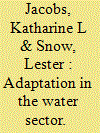

|
|
|
|
|
| Summary/Abstract |
Water management activities involve a complex and interconnected web of science, infrastructure considerations, societal expectations, and institutional limitations that has evolved over time. Much of the water management system's current complexity developed in response to the interests of local water users and land owners, historical water supply and demand issues, political demands, and water quality and environmental considerations. Climate change poses a new set of questions for water managers and may require more flexible solutions than those that have evolved historically. Although the implications of changes in the climate on water supply and demand are recognized (if not well quantified), ongoing changes in temperature and precipitation, as well as the linkages between environmental and societal factors, lead to major uncertainties in future conditions. New tools, techniques, and institutions will be needed to sustain water supplies for communities and watersheds in the future.
|
|
|
|
|
|
|
|
|
|
|
|
|
|
|
|
| 2 |
ID:
094616


|
|
|
|
|
| Publication |
London, Earthscan, 2009.
|
| Description |
xxvi, 397p.
|
| Standard Number |
9781844077458
|
|
|
|
|
|
|
|
|
|
|
|
Copies: C:1/I:0,R:0,Q:0
Circulation
| Accession# | Call# | Current Location | Status | Policy | Location |
| 054865 | 363.61/BIC 054865 | Main | On Shelf | General | |
|
|
|
|
| 3 |
ID:
099426
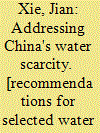

|
|
|
|
|
| Publication |
Washington, DC, World Bank, 2009.
|
| Description |
xxxiii, 160p.
|
| Standard Number |
9780821376454
|
|
|
|
|
|
|
|
|
|
|
|
Copies: C:1/I:0,R:0,Q:0
Circulation
| Accession# | Call# | Current Location | Status | Policy | Location |
| 055319 | 333.910951/XIE 055319 | Main | On Shelf | General | |
|
|
|
|
| 4 |
ID:
097149
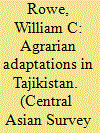

|
|
|
|
|
| Publication |
2010.
|
| Summary/Abstract |
In Central Asia, agriculture and water management have ranked as the two most important economic activities in this arid environment. These activities gained even more prominence during the Soviet era as planners expanded irrigation into previously marginal land that bolstered their vision that the best land be allocated exclusively for cotton production. In the wake of the fall of the Soviet Union, Tajikistan has enacted laws meant to expand and clarify land use categories to meet the dual targets of expanding food production within the country while maintaining as much land as possible in cotton production - their economic mainstay. To this end, the Tajik government instituted five categories of land tenure. Though comprehensive, these new dispositions merely mask a continuation of top-down agrarian decision making implemented during the Soviet period. Consequently, this change has created new problems for farm labourers as they struggle to adapt to post-Soviet life and negotiate with the new bureaucracy in the face of 'de-modernization' and the loss of jobs, wages, and in many cases, access to productive land. This research demonstrates that the means by which the Tajik government expanded food production has contributed to agricultural problems apparent at the time of independence.
|
|
|
|
|
|
|
|
|
|
|
|
|
|
|
|
| 5 |
ID:
193588
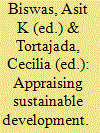

|
|
|
|
|
| Publication |
New Delhi, Oxford University Press, 2005.
|
| Description |
xviii, 223p.: table, figurespbk
|
| Standard Number |
9780195668919
|
|
|
|
|
|
|
|
|
|
|
|
Copies: C:1/I:0,R:0,Q:0
Circulation
| Accession# | Call# | Current Location | Status | Policy | Location |
| 060495 | 333.91/BIS 060495 | Main | On Shelf | General | |
|
|
|
|
| 6 |
ID:
130710
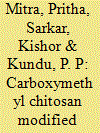

|
|
|
|
|
| Publication |
2014.
|
| Summary/Abstract |
The feasibility of carboxymethyl chitosan intercalated montmorillonite (CMCTS-MMT) clay used as a low-costand effective adsorbent for removal of cationic dye, crystal violet from the aqueous solution has been investigated.The synthesis of CMCTS-MMT was confirmed from the analytical information based on the characterization carried out by Fourier transformation infrared spectroscopy, x-ray diffraction data. During the removal process, batch technique was used and the effect of initial dye concentration, pH, temperature and weight ratio variation of sample composition were evaluated. Sorption process was analysed using pseudo-first order and pseudo-second order kinetic models. The data showed that the second order kinetic model was more appropriate for the absorption of thepresent dye. The equilibrium adsorption isotherms have been analyzed with the help of Langmuir, Freundlich and Redlich-Peterson analytical models. It was observed that the experimental data correlated reasonably well by the Redlich-Peterson and Langmuir isotherms. The desorbed CMCTS-MMT could be reused for adsorption of cationicdye. To investigate the changes in surface morphology of CMCTS-MMT after sorption, scanning electron microscopy analysis were done before and after adsorption of the cationic dye. Finally, the results in this study confirmed thatCMCTS-MMT may be an attractive contender for removal of cationic dyes from the waste water.
|
|
|
|
|
|
|
|
|
|
|
|
|
|
|
|
| 7 |
ID:
083642
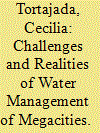

|
|
|
| 8 |
ID:
090625
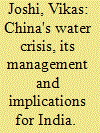

|
|
|
| 9 |
ID:
193563
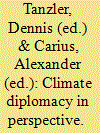

|
|
|
|
|
| Publication |
Berlin, Berliner Wissenschafts-Verlag, 2012.
|
| Description |
143p.pbk
|
| Standard Number |
9783830530558
|
|
|
|
|
|
|
|
|
|
|
|
Copies: C:1/I:0,R:0,Q:0
Circulation
| Accession# | Call# | Current Location | Status | Policy | Location |
| 060488 | 363.5492056/TAAN 060488 | Main | On Shelf | General | |
|
|
|
|
| 10 |
ID:
085329


|
|
|
|
|
| Publication |
2008.
|
| Summary/Abstract |
Many case studies and some large-N research have shown that upstream-downstream cooperation in international river basins occurs quite frequently. The same holds for global water governance efforts more generally. Yet such findings are blind in one eye because they focus primarily on political commitments or compliance with international agreements. A policy performance metric (PER) allows for a more substantive assessment of success or failure in international water governance. To test its usefulness, this article applies this metric to the Naryn/Syr Darya basin, a major international river system in Central Asia. Management of the Toktogul reservoir, the main reservoir in the Naryn/Syr Darya basin, was internationalized in 1991 when the Soviet Union collapsed. Compliance with an international agreement, concluded in 1998, has been quite high. This agreement establishes an international trade-off between water releases for upstream hydropower production in winter and water releases for downstream irrigation in summer. However, performance of this agreement over time has been very low and highly variable. The management system in place is therefore in urgent need of reform. Studies of international and global water governance should pay more attention to the degree to which political commitments actually further de facto problem solving.
|
|
|
|
|
|
|
|
|
|
|
|
|
|
|
|
| 11 |
ID:
193191
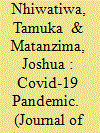

|
|
|
|
|
| Summary/Abstract |
Man-made reservoirs are constructed to meet certain purposes and Lake Kariba, Zimbabwe, was designed for hydroelectric power generation. However, it has developed other multiple uses, and the growth of fisheries on the lake has had a significant impact on the livelihoods of local communities. The declaration of Covid-19 as a pandemic in Zimbabwe in March 2020 was quickly followed by the imposition of national lockdowns with varying levels of severity up to the present day. This was done to curtail the spread of the disease, meanwhile enhancing the nation’s capacity in terms of acquiring testing kits, constructing more admission and quarantine centres as well as educating the people about ways to keep safe. In response to the calls by the government to monitor the movement of people and compliance of the lockdown rules, the Zimbabwe National Parks and Wildlife Management Authority (ZNPWMA), the governing body of the Lake Kariba fisheries, imposed rules that have significantly impacted the fishing communities at Lake Kariba. Both gillnet fishers and rod and line fishers have been impacted, but our focus here is on women rod and line fishers. Using the precarious livelihoods conceptual frameworks, we show how the changes in water management during the Covid-19 pandemic lockdowns has generated high levels of precariousness on the livelihoods of women at Kariba. We define precariousness as the condition of uncertainties brought to the women fishers by changes in water restrictions. The precarity of women was induced by several factors. For instance, the women fishers reported that restrictions to accessing fish in areas with high catches impacted them. They are also now obliged to pay exorbitant fishing fees in a way to discourage them to fish; they were frequently chased away from the Lake by ZNPWMA officers; they had limited amount of time to fish due to curfews; and failure to comply results in heavy fines imposed on them among other challenges. We show how these challenges interact with the current Zimbabwe socio-economic crisis to worsen the precariousness and vulnerability of women fishers at Lake Kariba. Data presented in this manuscript are based on participant observation and interviews with women fishers at Lake Kariba.
|
|
|
|
|
|
|
|
|
|
|
|
|
|
|
|
| 12 |
ID:
152528
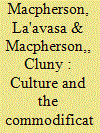

|
|
|
|
|
| Summary/Abstract |
While ‘solutions’ to challenges of water supply in the Pacific may seem obvious to hydrologists, engineers and planners, their implementation may not be straightforward. Water is embedded in cultural, religious and political contexts, and what seems obvious to planners may seem neither obvious, nor acceptable, to citizens. However, these contexts change continuously, and opportunities arise for changes in narratives around ownership, supply and management of water. Citizens' beliefs about the state's ‘rights’ will vary with societal context, and will shape the ways in which ownership and management of water is worked out in specific locations. This paper outlines thinking and discourses around ownership and management of fresh water in Samoa, and the constraints which culture has imposed on water supply over time. Water discourses have shifted from questions about ownership of specific sources to general discussions about conservation and management of natural resources. This shift has resulted, in part, from the ways in which government has managed the process and, in part, from growing public awareness of water within the larger environmental context. The paper focuses on Samoan material, but some of the generic issues have wider significance in the Pacific because similar variables combine in similar ways.
|
|
|
|
|
|
|
|
|
|
|
|
|
|
|
|
| 13 |
ID:
127771
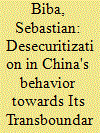

|
|
|
|
|
| Publication |
2014.
|
| Summary/Abstract |
Fresh water has no substitute, and its availability has been declining sharply around the globe. In Asia, China's role as a multidirectional and transborder water provider is unmatched. Analysis of China's behavior towards its transboundary rivers is therefore pivotal. By examining three different case studies-the Mekong River in Southeast Asia, the Brahmaputra River in South Asia and the Irtysh and Ili Rivers in Central Asia-this article seeks to lay the theoretical groundwork for understanding China's behavior. It pits previously applied realist rationales against the more recent notion of desecuritization strategies and makes a case for the latter. While desecuritization implies non- or de-escalation, it does not necessarily mean genuine long-term cooperation. The future of Asia's shared waters may thus be a contentious one.
|
|
|
|
|
|
|
|
|
|
|
|
|
|
|
|
| 14 |
ID:
139822


|
|
|
|
|
| Summary/Abstract |
Static models used in economics and ecology ignore dynamic processes at work in both human and natural systems. In the case of water management, whether for quantity or quality, static models fail to connect changing human demands on water systems with changing supplies due to short-run climate variations and long-run climate change. Water markets provide a way of connecting human demands to nature's supplies through prices, which signal values and scarcity. For water markets to make this connection, water rights must be well-defined, enforced, and tradeable. When they are, entrepreneurs are able to meet old and new demands on water ecosystems in novel ways, as examples in this essay illustrate.
|
|
|
|
|
|
|
|
|
|
|
|
|
|
|
|
| 15 |
ID:
129917
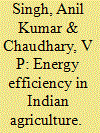

|
|
|
| 16 |
ID:
095336
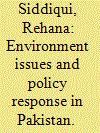

|
|
|
| 17 |
ID:
076705
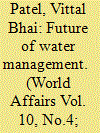

|
|
|
| 18 |
ID:
132871
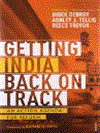

|
|
|
|
|
| Publication |
Gurgaon, Random House India, 2014.
|
| Description |
xii, 333p.Hbk
|
| Standard Number |
9788184005691
|
|
|
|
|
|
|
|
|
|
|
|
Copies: C:1/I:0,R:0,Q:0
Circulation
| Accession# | Call# | Current Location | Status | Policy | Location |
| 057860 | 330.954/DEB 057860 | Main | On Shelf | General | |
|
|
|
|
| 19 |
ID:
085330
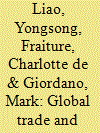

|
|
|
|
|
| Publication |
2008.
|
| Summary/Abstract |
Agricultural trade and water use are intrinsically linked. The case of China illustrates how (1) trade liberalization may impact water use; and (2) failure to consider water resources may distort analysis of trade liberalization. This article incorporates water constraints into forecasts of future agriculture in China and thereby creates a new set of scenarios that explicitly examine linkages between agriculture, water, and global trade. These new assessments show that many existing projections regarding agriculture in China are unrealistic due to water scarcity. For instance, China may import more wheat and export fewer vegetables and fruits than has typically been predicted. The findings also indicate that WTO accession provides China with opportunities to better manage demand for water in its agricultural sector while still addressing key food security concerns. The article emphasizes that it is crucial to include water as a factor of production when analyzing global agricultural trade. Global governance mechanisms of trade, such as the WTO, need to fulfill their key role in the design of effective water resources policy.
|
|
|
|
|
|
|
|
|
|
|
|
|
|
|
|
| 20 |
ID:
085325
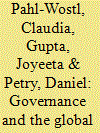

|
|
|
|
|
| Publication |
2008.
|
| Summary/Abstract |
Public policy on water has long been approached in the context of a locality, a country, or a river basin. However, scientific evidence now provides compelling arguments for adopting a global perspective on water management. This article argues that water governance today needs a multilevel design, including a significant global dimension. The discussion defines global water governance, highlights the implications for multilevel governance, and examines global water governance through the lens of governance typologies. The analysis along the categories of globalization/regionalization, centralization/decentralization, formality/informality, and state/nonstate actors and processes reveals that current global water governance is a fragmented, mobius-web arrangement. The article concludes by considering possible future trajectories of global water governance.
|
|
|
|
|
|
|
|
|
|
|
|
|
|
|
|
|
|
|
|
|